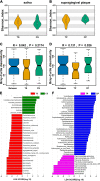Dysbiosis of Oral Microbiota and Metabolite Profiles Associated with Type 2 Diabetes Mellitus
- PMID: 36625596
- PMCID: PMC9927158
- DOI: 10.1128/spectrum.03796-22
Dysbiosis of Oral Microbiota and Metabolite Profiles Associated with Type 2 Diabetes Mellitus
Abstract
Several previous studies have shown that oral microbial disorders may be closely related to the occurrence and development of type 2 diabetes mellitus (T2DM). However, whether the function of oral microorganisms and their metabolites have changed in patients with T2DM who have not suffered from any oral diseases has not been reported. We performed metagenomic analyses and nontargeted metabolic analysis of saliva and supragingival plaque samples from patients with T2DM who have not suffered any oral diseases and normal controls. We found that periodontal pathogens such as Porphyromonas gingivalis and Prevotella melaninogenica were significantly enriched, while the abundances of dental caries pathogens such as Streptococcus mutans and Streptococcus sobrinus were not significantly different in patients with T2DM compared to those in normal controls. Metabolomic analyses showed that the salivary levels of cadaverine and L-(+)-leucine of patients with T2DM were significantly higher than those of normal controls, while the supragingival plaque levels of N-acetyldopamine and 3,4-dimethylbenzoic acid in patients with T2DM were significantly higher than those in the normal controls. Additionally, we identified the types of oral microorganisms related to the changes in the levels of circulating metabolites, and the oral microorganisms were involved in the dysregulation of harmful metabolites such as cadaverine and n, n-dimethylarginine. Overall, our study first described the changes in the composition of oral microorganisms and their metabolites in patients with T2DM who have not suffered any oral diseases, which will provide a direct basis for finding oral biomarkers for early warning of oral diseases in T2DM. IMPORTANCE The incidence of oral diseases in type 2 diabetic patients might increase, and the severity might also be more serious. At present, the relationship between oral microorganisms and type 2 diabetes mellitus (T2DM) has become a hot topic in systemic health research. However, whether the function of oral microorganisms and their metabolites have changed in patients with T2DM who have not suffered from any oral diseases has not been reported. We found that even if the oral condition of T2DM is healthy, their oral microbes and metabolites have changed, thus increasing the risk of periodontal disease. Our study first described the changes in the composition of oral microorganisms and their metabolites in T2DM who have not suffered any oral diseases and revealed the correlation between oral microorganisms and their metabolites, which will provide a direct basis for finding oral biomarkers for early warning of oral diseases in patients with T2DM.
Keywords: metabolomic; metagenomic; oral diseases; oral microbiome; type 2 diabetes mellitus.
Conflict of interest statement
The authors declare no conflict of interest.
Figures




Similar articles
-
The oral microbiome profile and biomarker in Chinese type 2 diabetes mellitus patients.Endocrine. 2020 Jun;68(3):564-572. doi: 10.1007/s12020-020-02269-6. Epub 2020 Apr 3. Endocrine. 2020. PMID: 32246318
-
The microbiological profiles of saliva, supragingival and subgingival plaque and dental caries in adults with and without type 2 diabetes mellitus.Oral Microbiol Immunol. 2007 Jun;22(3):175-81. doi: 10.1111/j.1399-302X.2007.00341.x. Oral Microbiol Immunol. 2007. PMID: 17488443
-
[Saliva microbiota and metabolite in individuals with caries or periodontitis].Zhonghua Kou Qiang Yi Xue Za Zhi. 2023 Feb 9;58(2):131-142. doi: 10.3760/cma.j.cn112144-20220829-00464. Zhonghua Kou Qiang Yi Xue Za Zhi. 2023. PMID: 36746446 Chinese.
-
Effects of Oral Glucose-Lowering Agents on Gut Microbiota and Microbial Metabolites.Front Endocrinol (Lausanne). 2022 Jul 13;13:905171. doi: 10.3389/fendo.2022.905171. eCollection 2022. Front Endocrinol (Lausanne). 2022. PMID: 35909556 Free PMC article. Review.
-
Can metagenomics unravel the impact of oral bacteriome in human diseases?Biotechnol Genet Eng Rev. 2023 Apr;39(1):85-117. doi: 10.1080/02648725.2022.2102877. Epub 2022 Jul 21. Biotechnol Genet Eng Rev. 2023. PMID: 35861776 Review.
Cited by
-
Microbiome composition and metabolic pathways in shallow and deep periodontal pockets.Sci Rep. 2025 Apr 15;15(1):12926. doi: 10.1038/s41598-025-97531-0. Sci Rep. 2025. PMID: 40234709 Free PMC article.
-
Influence of nitrate-containing arugula juice on nitrate-reducing oral bacteria and periodontopathogens in smokers' biofilm.Front Dent Med. 2025 May 9;6:1545479. doi: 10.3389/fdmed.2025.1545479. eCollection 2025. Front Dent Med. 2025. PMID: 40416551 Free PMC article.
-
Differences in oral microbiota associated with type 2 diabetes mellitus between the Dai and Han populations.J Oral Microbiol. 2024 Dec 24;17(1):2442420. doi: 10.1080/20002297.2024.2442420. eCollection 2025. J Oral Microbiol. 2024. PMID: 39763576 Free PMC article.
-
Microbiomic insights into the oral microbiome's role in type 2 diabetes mellitus: standardizing approaches for future advancements.Front Endocrinol (Lausanne). 2024 Nov 29;15:1416611. doi: 10.3389/fendo.2024.1416611. eCollection 2024. Front Endocrinol (Lausanne). 2024. PMID: 39678196 Free PMC article. Review.
-
Oral microbiota and respiratory diseases: advances and perspectives.Clin Microbiol Rev. 2025 Jun 12;38(2):e0015024. doi: 10.1128/cmr.00150-24. Epub 2025 Apr 2. Clin Microbiol Rev. 2025. PMID: 40172191 Review.
References
-
- Saeedi P, Petersohn I, Salpea P, Malanda B, Karuranga S, Unwin N, Colagiuri S, Guariguata L, Motala AA, Ogurtsova K, Shaw JE, Bright D, Williams R, IDF Diabetes Atlas Committee . 2019. Global and regional diabetes prevalence estimates for 2019 and projections for 2030 and 2045: results from the International Diabetes Federation Diabetes Atlas, 9(th) edition. Diabetes Res Clin Pract 157:107843. doi: 10.1016/j.diabres.2019.107843. - DOI - PubMed
-
- Laouali N, El Fatouhi D, Aguayo G, Balkau B, Boutron-Ruault M-C, Bonnet F, Fagherazzi G. 2021. Type 2 diabetes and its characteristics are associated with poor oral health: findings from 60,590 senior women from the E3N study. BMC Oral Health 21:315. doi: 10.1186/s12903-021-01679-w. - DOI - PMC - PubMed
Publication types
MeSH terms
Substances
LinkOut - more resources
Full Text Sources
Medical

